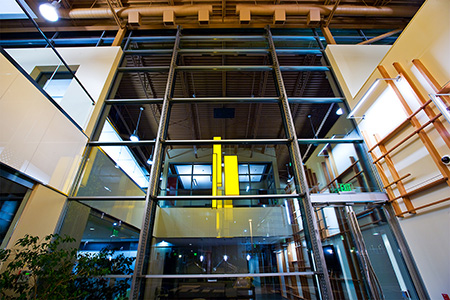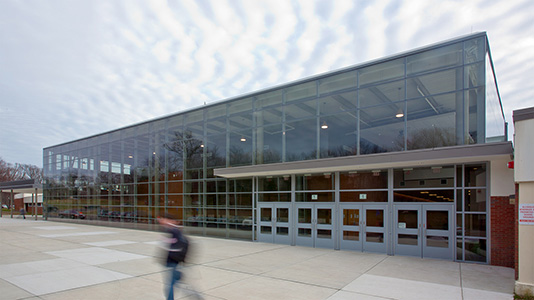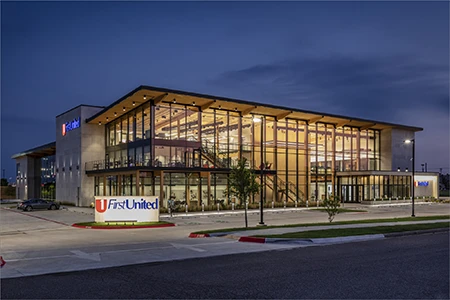Here’s what you need to know about steel curtain wall systems to get started on your next project.


Building teams are constantly pushing the envelope and finding new ways to make curtain wall designs more efficient and beautiful. During this process, a number of challenges can arise. Here’s a look at some of the most common, along with how steel curtain walls are rising to the occasion.
Metal Corrosion
In the early 18th and 19th century metal corrosion was a big problem for curtain walls. Indeed, early steel curtain walls were vulnerable to rust, and the industry turned to more corrosion-resistant materials like aluminum to help rectify the problem.
In recent years, manufacturers have introduced advanced systems that solve the age old rust problems associated with steel. These steel curtain walls are built with a continuous gasket across the full width of the frames to prevent moisture intrusion. This new technology helps prevent water in the glazing cavity from coming into direct contact with the steel frame. While a wide variety of finishes are available to help design teams achieve a specific appearance, from powder-coating to liquid-applied finishes, the gasketing is so effective that no special coating is required to prevent corrosion.
To achieve a specific design intent or enhance corrosion resistance (i.e. applications in coastal areas), the exterior caps or interior back mullions can be made from stainless steel.
Water Infiltration

In window or curtain wall applications, it is important to address a system’s exposure to water. Modern day steel systems successfully overcome water penetration issues by employing gaskets that cover the face of the steel (at the back surface of the glazing pocket or cavity). This tactic completely isolates the steel from any contact with water in the glazing pocket. With the continuous gasket on the entire front face of the steel profile in a captured, fixed glazed or SSG application, air penetration is also nearly nonexistent.
Once the framing is erected and the gaskets are sealed, steel systems use conventional aluminum or stainless steel pressure plates and cover caps to hold the glass to the framing. The continuous gasket on the face of the main framing members and pressure plate system creates a two-lines-of-defense strategy, utilizing rainscreen principles to resist air and water penetration through the system.
When using SSG steel curtain walls, a small aluminum extrusion is structurally silicone glazed to the glass. Toggles are then inserted into the channel and fastened to a fully gasketed steel curtain wall framing system to retain the glass. The gasketing provides additional air- and water-resistance within the system. From an aesthetic perspective, these weather joints look the same as a conventional barrier system. See the SteelBuilt Curtainwall® SSG System for more information.
Energy Efficiency
It’s understood that curtain wall framing materials have a high thermal conductivity compared to other elements of the building envelope. In turn, design teams pair framing systems with low-emissivity (low-e) glass or other energy-efficient glazing to help boost overall fenestration system thermal performance values. Even so, the system’s overall thermal efficiency remains significantly less effective where the captured or retained glass edge meets the supporting frames.
With a thermal conductivity of approximately 31 Btu per hour (about 74 percent less than aluminum), steel can help reduce the potential for heat gain and loss between the glass and frames. Its performance is equivalent to that of thermally broken aluminum frames, allowing the steel frame profiles to help reduce heat flow.

Historically, exposure to moisture was the primary catalyst for weathering in traditional steel-framed curtain wall assemblies. Because moisture increases steel’s vulnerability to corrosion, it is detrimental to a curtain wall’s durability and structural integrity. Corroded steel frames can also be unsightly. However, manufacturers have figured out how to protect steel frames from moisture using innovative manufacturing and installation techniques, making them suitable for modern curtain wall applications.
Modern, steel-framed curtain wall systems employ continuous silicone gaskets that cover the width of the frame to overcome water penetration issues. This technique keeps water off the tops of glass units and directs it to the vertical frame members. This tactic, along with properly sealed lap joints, completely isolates steel from coming into contact with water in the glazing pocket. When tested to AAMA and ASTM standards, steel-framed curtain walls with full gasket fabrication demonstrated water penetration resistance as low as 15 and 30 pounds per square foot (psf). Not only does this support a weathertight interior, but it also helps bolster steel frame durability by protecting it from moisture.
Once the gaskets are sealed, steel-framed systems use more conventional aluminum or stainless-steel pressure plates and cover caps to hold the glass to the framing. The continuous gasket and pressure plate system creates a two-lines-of-defense strategy against air and water penetration. Additionally, with gaskets, a steel-framed assembly also eliminates air penetration. This, in turn, minimizes the risk of oxidation and supports energy efficiency.
To preserve the curtain wall’s appearance and further protect against corrosion, leading manufacturers offer steel frames layered with powder or wet coating as well as corrosion-resistant steel frame protections, such as double-sided pre-galvanization, which includes a durable primer under a final color coat to ensure longevity.
Thanks to these practices, modern steel frames are durable and corrosion-resistant, maintaining their strength and aesthetic appeal for years to come. See TGP’s architectural steel frames for more information.